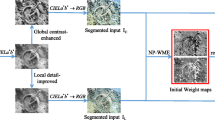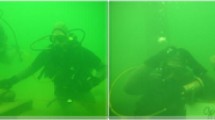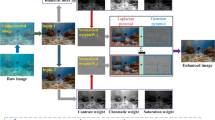Abstract
The information in a single underwater image is insufficient due to the complexity of the underwater environment, which makes it challenging to meet the expectations of marine research. In this paper, we proposed a visual quality enhancement method for underwater images based on multi-feature prior fusion (MFPF), achieved by extracting and fusing multiple feature priors of underwater images. Complementary multi-features enhance the visual quality of underwater images. We designed a color correction method based on self-adaptive standard deviation, which realizes the color offset correction based on the dominant color of the underwater image. A gamma correction power function and spatial linear adjustment were also applied to achieve a set of artificial exposure map sequences obtained from a single degraded image and enhance the dark area’s brightness and structural details. This design makes full use of the advantages of white balance, guided filtering, and multi-exposure sequence technology. And it uses a multi-scale fusion of various prior features to enhance underwater images. The experimental results show that by applying the multi-feature prior fusion scheme, this design comprehensively solves various degenerated problems, removes over-enhancement, and improves dark details.
















Similar content being viewed by others
References
Zhou J, Zhang D, Zhang W (2020) Classical and state-of-the-art approaches for underwater image defogging: a comprehensive survey[J]. Front Inf Technol Electron Eng 21(12):1745–1769
Zhou J, Zhang D, Zhang W (2020) Multiscale Fusion Method for the Enhancement of Low-Light Underwater Images[J]. Math Problems Eng 2020
Li C, Guo J, Guo C (2018) Emerging from water: Underwater image color correction based on weakly supervised color transfer[J]. IEEE Signal Process Lett 25(3):323–327
Muniraj M, Dhandapani V (2021) Underwater image enhancement by combining color constancy and dehazing based on depth estimation[J]. Neurocomputing
Fu X, Cao X (2020) Underwater image enhancement with global–local networks and compressed-histogram equalization[J]. Signal Process Image Commun 86:115892
Hou G, Pan Z, Huang B et al (2018) Hue preserving-based approach for underwater colour image enhancement[J]. IET Image Proc 12(2):292–298
Hou G, Li J, Wang G et al (2020) A novel dark channel prior guided variational framework for underwater image restoration[J]. J Vis Commun Image Represent 66:102732
Anwar S, Li C (2020) Diving deeper into underwater image enhancement: A survey[J]. Signal Process Image Commun 89:115978
Ghani ASA, Isa NAM (2015) Underwater image quality enhancement through integrated color model with Rayleigh distribution[J]. Appl Soft Comput 27:219–230
Iqbal K, Odetayo M, James A et al (2010) Enhancing the low quality images using unsupervised colour correction method[C]//2010 IEEE International Conference on Systems, Man and Cybernetics. IEEE, pp 1703–1709
Fu X, Zhuang P, Huang Y et al (2014) A retinex-based enhancing approach for single underwater image[C]//2014 IEEE international conference on image processing (ICIP). IEEE, pp 4572–4576
Zhuang P, Li C, Wu J (2021) Bayesian retinex underwater image enhancement[J]. Eng Appl Artif Intell 101:104171
Ancuti CO, Ancuti C, De Vleeschouwer C et al (2017) Color balance and fusion for underwater image enhancement[J]. IEEE Trans Image Process 27(1):379–393
Zhou J, Zhang D, Zhang W (2021) A multifeature fusion method for the color distortion and low contrast of underwater images[J]. Multimedia Tools Appl 80(12):17515–17541
Jaffe JS (1990) Computer modeling and the design of optimal underwater imaging systems[J]. IEEE J Oceanic Eng 15(2):101–111
Drews P, Nascimento E, Moraes F et al (2013) Transmission estimation in underwater single images, 2013[C]. IEEE International Conference on Computer Vision Workshops, pp 825–830
Galdran A, Pardo D, Picón A et al (2015) Automatic red-channel underwater image restoration[J]. J Vis Commun Image Represent 26:132–145
Huang D, Wang Y, Song W et al (2018) Shallow-water image enhancement using relative global histogram stretching based on adaptive parameter acquisition, 2018[C]. International conference on multimedia modeling. Springer, Cham, pp 453–465
Peng YT, Cao K, Cosman PC (2018) Generalization of the dark channel prior for single image restoration[J]. IEEE Trans Image Process 27(6):2856–2868
Song W, Wang Y, Huang D et al (2018) A rapid scene depth estimation model based on underwater light attenuation prior for underwater image restoration, 2018[C]. Pacific Rim Conference on Multimedia. Springer, Cham, pp 678–688
Zhou J, Liu Z, Zhang W et al (2021) Underwater image restoration based on secondary guided transmission map[J]. Multimedia Tools Appl 80(5):7771–7788
Li C, Guo C, Ren W et al (2019) An underwater image enhancement benchmark dataset and beyond[J]. IEEE Trans Image Process 29:4376–4389
Guo Y, Li H, Zhuang P (2019) Underwater image enhancement using a multiscale dense generative adversarial network[J]. IEEE J Oceanic Eng 45(3):862–870
Chen X, Yu J, Kong S et al (2019) Towards real-time advancement of underwater visual quality with GAN[J]. IEEE Trans Industr Electron 66(12):9350–9359
Li C, Anwar S, Porikli F (2020) Underwater scene prior inspired deep underwater image and video enhancement[J]. Pattern Recog 98:107038
Li C, Anwar S, Hou J et al (2021) Underwater Image Enhancement via Medium Transmission-Guided Multi-Color Space Embedding[J]. IEEE Trans Image Process 30:4985–5000
Ancuti C O, Ancuti C, Bekaert P (2010) Effective single image dehazing by fusion, 2010[C]. IEEE International Conference on Image Processing, pp 3541–3544
Mertens T, Kautz J, Van Reeth F (2007) Exposure fusion, 2007[C]. 15th Pacific Conference on Computer Graphics and Applications (PG'07), pp 382–390
Ancuti CO, Ancuti C (2013) Single image dehazing by multi-scale fusion[J]. IEEE Trans Image Process 22(8):3271–3282
Ogden JM, Adelson EH, Bergen JR et al (1985) Pyramid-based computer graphics[J]. RCA Eng 30(5):4–15
Moon SW, Lee HS, Eom IK (2020) Improvement of underwater colour correction using standard deviation ratio[J]. Electron Lett 56(20):1051–1054
Li CY, Guo JC, Cong RM et al (2016) Underwater image enhancement by dehazing with minimum information loss and histogram distribution prior[J]. IEEE Trans Image Process 25(12):5664–5677
He K, Sun J, Tang X (2012) Guided image filtering[J]. IEEE Trans Pattern Anal Mach Intell 35(6):1397–1409
Zheng M, Qi G, Zhu Z et al (2020) Image dehazing by an artificial image fusion method based on adaptive structure decomposition[J]. IEEE Sens J 20(14):8062–8072
Zhu Z, Wei H, Hu G et al (2020) A novel fast single image dehazing algorithm based on artificial multiexposure image fusion[J]. IEEE Trans Instrum Meas 70:1–23
Galdran A (2018) Image dehazing by artificial multiple-exposure image fusion[J]. Signal Process 149:135–147
Nejati M, Karimi M, Soroushmehr SMR et al (2017) Fast exposure fusion using exposedness function[C]//2017 IEEE International Conference on Image Processing (ICIP). IEEE, pp 2234–2238
Achanta R, Hemami S, Estrada F et al (2009) Frequency-tuned salient region detection, 2009[C]. 2009 IEEE Conference on Computer Vision and Pattern Recognition, pp 1597-1604
Mertens T, Kautz J, Van Reeth F (2007) Exposure fusion, 2007[C]. 15th Pacific Conference on Computer Graphics and Applications (PG'07). IEEE, pp 382–390
Liu R, Fan X, Zhu M et al (2020) Real-world underwater enhancement: challenges, benchmarks, and solutions under natural light[J]. IEEE Trans Circuits Syst Video Technol 30(12):4861–4875
Land EH (1977) The retinex theory of color vision. Sci Am 237(6):108–129
Buchsbaum G (1980) A spatial processor model for object colour perception[J]. J Franklin Inst 310(1):1–26
Finlayson G D, Trezzi E (2004) Shades of gray and colour constancy,2004[C]. Color and Imaging Conference. Society for Imaging Science and Technology, 2004(1), pp 37–41
Van De Weijer J, Gevers T, Gijsenij A (2007) Edge-based color constancy[J]. IEEE Trans Image Process 16(9):2207–2214
Gijsenij A, Gevers T, Van De Weijer J (2011) Improving color constancy by photometric edge weighting[J]. IEEE Trans Pattern Anal Mach Intell 34(5):918–929
Weng CC, Chen H, Fuh CS (2005) A novel automatic white balance method for digital still cameras, 2005[C]. IEEE International Symposium on Circuits and Systems, pp 3801–3804
Iqbal K, Salam RA, Osman A et al (2007) Underwater image enhancement using an integrated colour model[J]. IAENG Int J Comput Sci 34(2):239–244
Fu X, Fan Z, Ling M et al (2017) Two-step approach for single underwater image enhancement,2017[C]. International Symposium on Intelligent Signal Processing and Communication Systems (ISPACS), pp 789–794
Pan P, Yuan F, Cheng E (2018) Underwater image de-scattering and enhancing using dehazenet and HWD[J]. J Mar Sci Technol 26(4):6
Núñez JA, Cincotta PM, Wachlin FC (1996) Information entropy[M]. Chaos in Gravitational N-Body Systems. Springer, Dordrecht, pp 43–53
He N, Wang JB, Zhang LL et al (2015) An improved fractional-order differentiation model for image denoising[J]. Signal Process 112:180–188
Panetta K, Gao C, Agaian S (2015) Human-visual-system-inspired underwater image quality measures[J]. IEEE J Oceanic Eng 41(3):541–551
Wang S, Ma K, Yeganeh H et al (2015) A patch-structure representation method for quality assessment of contrast changed images[J]. IEEE Signal Process Lett 22(12):2387–2390
Yang M, Sowmya A (2015) An underwater color image quality evaluation metric[J]. IEEE Trans Image Process 24(12):6062–6071
Hautiere N, Tarel JP, Aubert D et al (2008) Blind contrast enhancement assessment by gradient ratioing at visible edges[J]. Image Anal Stereol 27(2):87–95
Wang Y, Guo J, Gao H et al (2021) UIEC^2-Net: CNN-based Underwater Image Enhancement Using Two Color Space[J]. 96:116250
Acknowledgements
Thanks to the data set provided by the joint laboratory of the Dalian University of Technology and Zhangzidao Group. We are also extremely grateful to the anonymous reviewers for their critical comments on the manuscript.
Funding
National Natural Science Foundation of China (No. 61702074); the Liaoning Provincial Natural Science Foundation of China (No. 20170520196); the Fundamental Research Funds for the Central Universities (Nos.3132019205 and 3132019354).
Author information
Authors and Affiliations
Corresponding authors
Ethics declarations
Disclosures
The authors declare that there are no conflicts of interest related to this paper.
Additional information
Publisher's note
Springer Nature remains neutral with regard to jurisdictional claims in published maps and institutional affiliations.
Rights and permissions
About this article
Cite this article
Zhou, J., Zhang, D. & Zhang, W. Underwater image enhancement method via multi-feature prior fusion. Appl Intell 52, 16435–16457 (2022). https://doi.org/10.1007/s10489-022-03275-z
Accepted:
Published:
Issue Date:
DOI: https://doi.org/10.1007/s10489-022-03275-z




